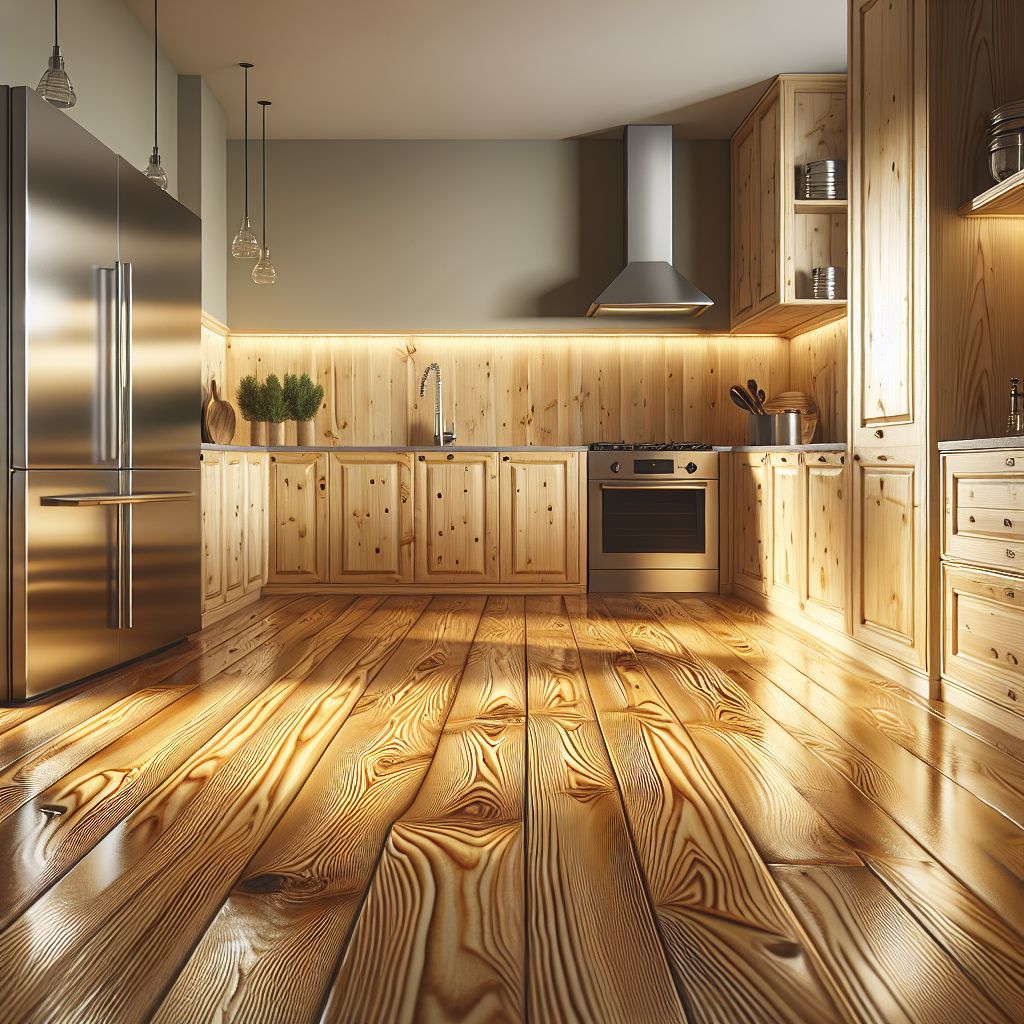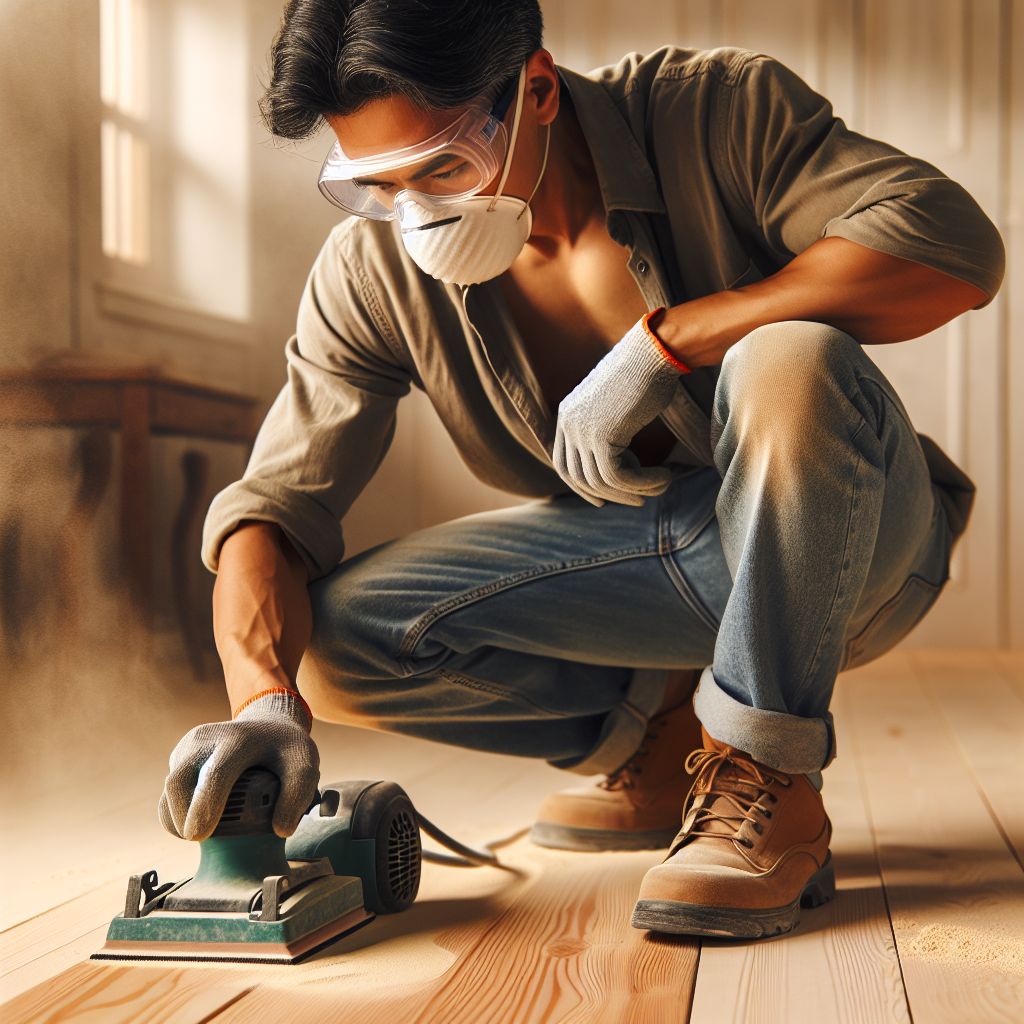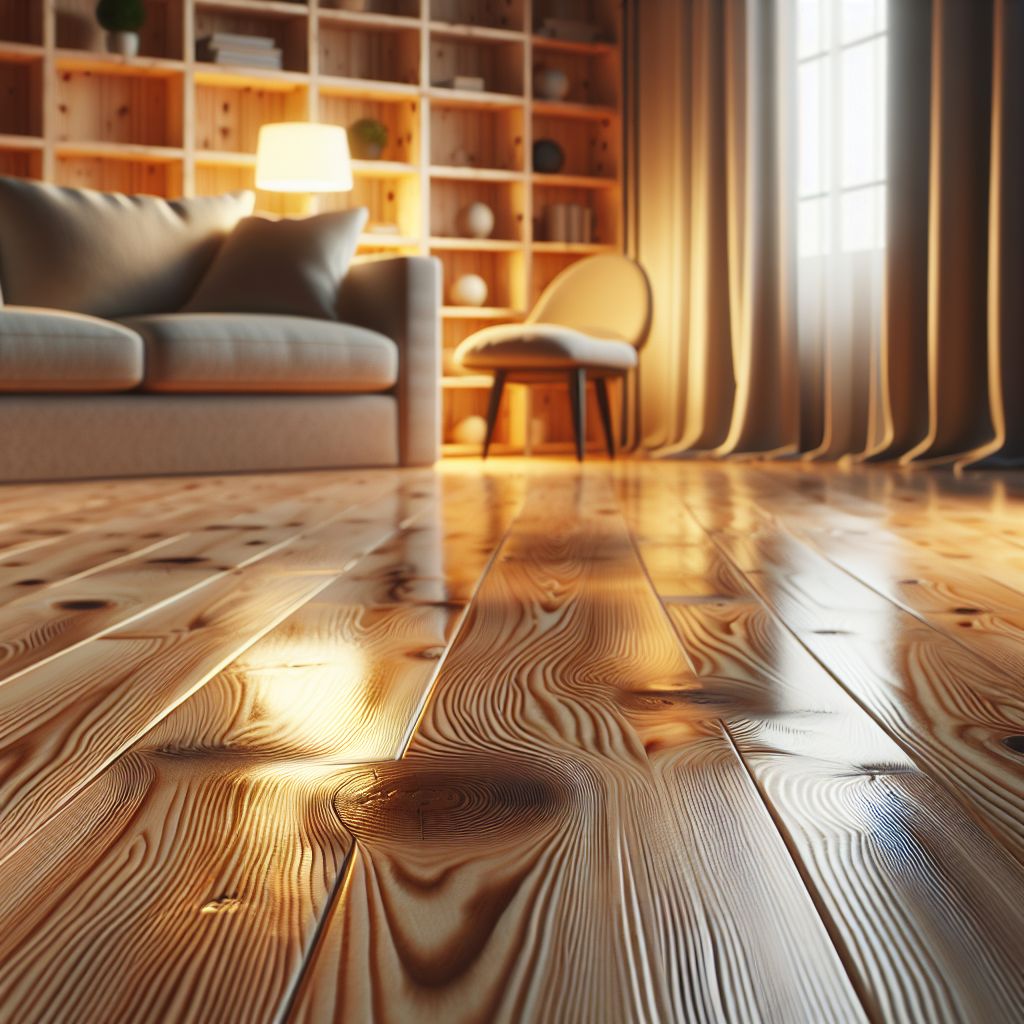
Key Takeaways
- Pine wood floors can be fully restored with DIY refinishing, enhancing their beauty and your home’s overall value.
- Proper preparation and gathering the right tools are essential for a successful refinishing project.
- Refinishing involves several steps: sanding, filling, staining (optional), and sealing the wood.
- Maintenance tips post-refinishing will help preserve the life and look of your pine floors.
- With patience and care, even deep scratches and worn areas can be rejuvenated, often without the need for professional help.
Why Give Your Pine Wood Floors a New Life?
Think about the countless steps, the laughs, the spills and stories your floors have witnessed. They deserve a bit of TLC. Refinishing pine floors not only removes unsightly scratches and stains but also protects the wood for years to come. It’s about preserving history and making new memories on a floor that looks as good as the day it was laid.
Time to Shine: The Perks of Refinished Pine Floors
Refinished floors are not just a treat for the eyes; they’re a practical choice. The smooth surface makes cleaning a breeze, keeping allergens at bay. Plus, a well-maintained floor is a long-lasting floor, meaning more years of enjoyment and less need for costly replacements.
Refinishing enhances beauty and restores the character of the wood. There’s nothing like the satisfaction of doing it yourself. You’ll learn a new skill, get a little workout, and have the ultimate bragging rights.
The Unseen Value: How Refinished Floors Can Boost Your Home’s Worth
Refinished floors can be a deal-maker for future buyers. They signal a well-maintained home and add to the aesthetic appeal. If you’re looking to sell, this could be the polish that clinches the deal.

Gathering Your Tools and Materials
Before diving into the refinishing process, you’ll need the right tools and materials. Trust me, having everything on hand before you start will save you time, frustration, and multiple trips to the hardware store.
The Refinishing Toolkit: What You’ll Need to Begin
Gather your tools:
- A drum or orbital sander
- Sandpaper of various grits
- Wood filler
- Stain (optional)
- Sealant
- Brushes or rollers
- Protective gear including gloves, goggles, and a mask.
Prepping Your Space: A Checklist
Preparation is key. Move furniture out, clean the floors thoroughly to remove dirt and grime, and make sure the room is well-ventilated. You’re setting the stage for a smooth refinishing experience.

Step-by-Step Pine Wood Floor Refinishing
Now, let’s break down the refinishing process into manageable steps. Let’s delve into the different tips and tricks to help you get the best results.
Step 1: Out with the Old: Sanding Your Floors
The first step is sanding. This removes the old finish and preps the wood for its new coat. You’ll start with a coarse grit to strip away the old and move to finer grits for a smooth finish. It’s a bit of a workout, but imagine the satisfaction when you see your floors coming back to life. Here are the steps:
Choosing the Right Grit for Pine
Pine is a softer wood, so you’ll want to start with a 30-60-grit sandpaper and work your way up to 120-grit for the final pass. This ensures you don’t damage the wood while still getting a smooth surface.
Sanding Techniques to Preserve the Wood
When sanding, go with the grain of the wood, not against it. This prevents scratches that can mar the floor’s surface. And remember to keep the sander moving; lingering too long in one spot can create dips and uneven surfaces.
For edges and corners, use a hand-held orbital sander or sanding block to sand the edges and corners of the room that the drum sander couldn’t reach. Once done, vacuum the floor thoroughly to remove all dust and debris. You may also want to wipe the floor with a tack cloth to pick up any remaining fine dust particles.
Step 2: Filling in the Blank: Using Wood Filler Wisely
Once the sanding is done, you’ll likely notice some gaps or holes that need filling. Wood filler is your friend here. It’s like putty for your floors, filling in those imperfections and creating a seamless surface. But not just any filler will do; you want one that’s stainable or matches your pine floor’s natural hue.
Apply the wood filler according to the manufacturer’s instructions. Be generous, but not extra—you can always sand off the excess later. Let it dry completely, which can take a few hours to overnight, depending on the product.
Patience is key. Rushing this step can result in a less-than-ideal finish, and that’s not what we’re after.
Tips for a Seamless Fill
For a seamless fill, use a putty knife to press the filler firmly into the gaps. Smooth it over with the flat edge of the knife for an even surface. And remember, the filler will shrink a bit as it dries, so it’s better to overfill than underfill.
After the filler has dried, take your sander for one more pass over the filled areas. This will remove the excess filler and ensure the surface is as smooth as silk. It’s all about creating that flawless finish.
How to Match the Wood Grain and Color
Matching the wood grain and color is a bit of an art. If you’re staining your floors, choose a filler that’s slightly lighter than the stain color. The filler will absorb the stain differently than the wood, so going lighter gives you more control over the final shade.
- Pick a filler shade lighter than your intended stain color.
- Test the filler and stain on a small, inconspicuous area first.
- Adjust the filler shade if needed before applying to the entire floor.
It’s all about blending. You want the filled areas to be nearly invisible once you’ve stained and sealed the floors.
Step 3: Staining for Success: Selecting and Applying Stain
Staining is optional, but if you want to change the color of your floors or enhance the natural wood grain, it’s a step you won’t want to skip. Select a stain that complements your home’s decor and test it in a discreet area first to ensure you’re happy with the color.
Let the stain dry completely, which could take up to 24 hours. The waiting game is tough, but it’s worth it for that perfect finish.
Testing Stains: Finding Your Perfect Shade
Before you commit to a stain, test it. Find a hidden spot or a scrap piece of pine and apply the stain. Let it dry completely to see the true color. This test run will save you from potential heartache if the color isn’t what you envisioned.
For example, if you’re going for a warm, honey-colored floor, you might choose a light oak stain. Test it, and if it’s too light once dry, you can mix in a bit of a darker stain like walnut to reach the desired shade.
Remember, you can always go darker with a second coat, but you can’t go lighter once the stain is applied.
Application Tricks for Even Coverage
When applying the stain, work in manageable sections and always go with the grain. Use a brush for edges and corners, and a rag or roller for larger areas. Keep a wet edge to avoid lap marks. If you’re using a rag, wear gloves to protect your hands and ensure an even application without fingerprints.
Step 4: Final Touches: Sealing and Protecting Your Floor
The final step in your refinishing journey is sealing the floor. This protective layer will lock in the stain and protect the wood from everyday wear and tear. Choose a sealant like polyurethane for its durability and ease of application.
- Opt for a water-based polyurethane for a clear finish or an oil-based one for a richer hue.
- Apply the sealant with a brush or roller, starting at the furthest corner of the room.
- Allow for proper ventilation and let each coat dry completely before applying the next.
Follow these steps to ensure that your floors are properly sealed and protected:
- Use a brush, roller, or floor applicator to apply a coat of polyurethane finish to the floor. Work in small sections, and be sure to apply the finish evenly.
- Allow the first coat to dry according to the manufacturer’s instructions, typically overnight.
- Lightly sand the floor with fine grit sandpaper (220 grit) to smooth out any imperfections and remove any bubbles or dust particles.
- Apply additional coats of polyurethane as needed, allowing each coat to dry completely before sanding and applying the next coat. Most floors will require 2-3 coats of finish for adequate protection.
Most importantly, follow the manufacturer’s instructions for the best results. The effort you put in now will ensure your floors stand the test of time.

Caring for Your Refinished Pine Floors
After all the hard work you’ve put into refinishing your pine floors, you’ll want to keep them looking as good as new for as long as possible. Proper care and maintenance are the keys to preserving the beauty and extending the life of your floors.
Maintenance Made Easy: Post-Refinishing Care Tips
Once your floors are sanded, stained, and sealed, they’ll need a little time to cure. Wait at least 48 hours before moving furniture back in, and consider using felt pads under furniture legs to prevent scratches. For cleaning, use a soft broom or a vacuum with a hardwood floor attachment to keep the floors dust-free. When it’s time to mop, use a damp—not wet—mop and a cleaner that’s safe for wood floors. Avoid harsh chemicals and excessive water, which can damage the finish and the wood underneath.
The Do’s and Don’ts of Pine Floor Upkeep
- Do use rugs in high-traffic areas to minimize wear.
- Don’t drag furniture across the floor.
- Do clean spills immediately to prevent staining.
- Don’t use steam cleaners or wet mops, which can cause warping and damage the finish.
Pine Floor Quick Fix Tips
Regular care will keep your floors looking great, but even the best-kept floors will eventually show signs of wear. Here’s how to handle common issues without a full refinish:
- For minor scratches, use a wood floor cleaner and a repair marker that matches your floor’s finish.
- If a board gets damaged, you can often replace just that board without refinishing the entire floor.
- For deeper scratches or gouges, wood filler and a bit of stain can work wonders.
By following these simple guidelines, you’ll keep your pine floors in top shape for years to come.

Frequently Asked Questions
How Often Should Pine Floors Be Refinished?
It depends on the level of traffic and wear, but typically, pine floors should be refinished every 10 to 15 years. If you take good care of them, you might stretch that to 20 years. Keep an eye on the high-traffic areas; when they start to look dull, it might be time for a touch-up.
Can Deep Scratches on Pine Floors Be Fixed During Refinishing?
Absolutely. Deep scratches can be sanded out during the refinishing process. If the scratch is too deep for sanding to fix, wood filler can be used before staining and sealing. Remember, pine is a softwood, so it’s more prone to scratches, but also more forgiving when it comes to repairs.
Is It Possible to Refinish Pine Floors Without Sanding?
There are products out there that claim to refinish floors without sanding, but they might not give you the same results. Sanding is essential for removing the old finish and for the new finish to adhere properly. If your floors are only slightly worn, a screen and recoat might suffice. This process involves lightly sanding the top layer of finish (screening) and then applying a new topcoat.
How Long Does It Take for Refinished Pine Floors to Dry?
After the final coat of sealant, you should wait at least 24 hours before walking on the floors with socks, 48 hours before moving furniture back in carefully, and a full week before rugs can be laid down. These times can vary based on humidity, temperature, and the specific products used, so always check the manufacturer’s recommendations.
Can You Change the Color of Your Pine Floors Through Refinishing?
Yes, you can change the color of your pine floors with stain during the refinishing process. Pine absorbs stain differently than other woods, so it’s important to test the stain on a small, inconspicuous area or a spare piece of pine to ensure you get the color you want. Be aware that some stains can look blotchy on pine, so you might need a pre-stain conditioner or a gel stain for an even color.
Refinishing your pine wood floors can be a rewarding DIY project that not only saves you money but also gives your space a fresh, new look. The process involves sanding down the floors to remove the old finish, filling any gaps or cracks, and then applying a new stain and sealant for protection. It’s important to choose the right products and follow each step carefully to achieve the best results.





Leave a Reply